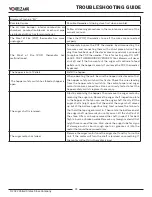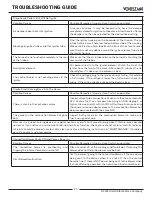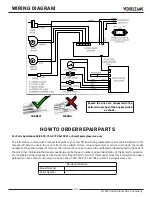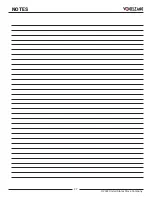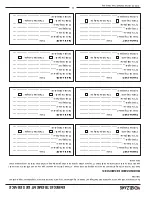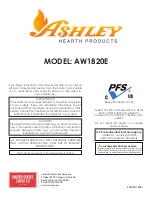
© 2022 United States Stove Company
13
OPERATION INSTRUCTIONS
PROPER FUEL
ATTENTION:
THIS APPLIANCE IS DESIGNED FOR THE USE
OF PELLETIZED FUEL THAT MEET OR EXCEED
THE STANDARD SET BY THE PELLET FUEL
INSTITUTE (PFI).
Your pellet stove is designed to burn premium hardwood
pellets that comply with the Pellet Fuels Institute (PFI)
standard (minimum of 40 lbs density per cubic ft, 1/4” to
5/16” diameter, length no greater than 1.5”, not less than
8,200 BTU/lb, moisture under 8% by weight, ash under 1%
by weight, and salt under 300 parts per million). Pellets
that are soft, contain excessive amounts of loose sawdust,
have been, or are wet, will result in reduced performance.
Store your pellets in a dry place. DO NOT store the fuel
within the installation clearances of the unit or within the
space required for refuelling and ash removal. Doing so
could result in a house fire. Do not over fire or use volatile
fuels or combustibles, doing so may cause a personal and
property damage hazards.
THIS STOVE IS APPROVED FOR BURNING PELLETIZED
WOOD FUEL ONLY! Factory-approved pellets are those
1/4” or 5/16” in diameter and not over 1” long. Longer or
thicker pellets sometimes bridge the auger flights, which
prevents proper pellet feed. Burning wood in forms other
than pellets is not permitted. It will violate the building
codes for which the stove has been approved and will void
all warranties. The design incorporates automatic feed of
the pellet fuel into the fire at a carefully prescribed rate. Any
additional fuel introduced by hand will not increase heat
output but may seriously impair the stoves performance
by generating considerable smoke. Do not burn wet
pellets. The stove’s performance depends heavily on the
quality of your pellet fuel. Avoid pellet brands that display
these characteristics:
•
Excess Fines – “Fines” is a term describing crushed
pellets or loose material that looks like sawdust or sand.
Pellets can be screened before being placed in hopper
to remove most fines.
• Binders – Some pellets are produced with materials to
hold the together, or “bind” them.
•
High ash content – Poor quality pellets will often create
smoke and dirty glass. They will create a need for more
frequent maintenance. You will have to empty the burn
pot plus vacuum the entire system more often. Poor
quality pellets could damage the auger. We cannot
accept responsibility for damage due to poor quality
pellet.
This heater is designed to burn only PFI Premium grade
pellets. DO NOT BURN:
1. Garbage;
2. Lawn clippings or yard waste;
3.
Materials containing rubber, including tires;
4. Materials containing plastic;
5. Waste petroleum products, paints or paint thinners, or
asphalt products;
6.
Materials containing asbestos;
7.
Construction or demolition debris;
8.
Railroad ties or pressure-treated wood;
9.
Manure or animal remains;
10. Salt water driftwood or other previously salt water
saturated materials;
11.
Unseasoned wood; or
12. Paper products, cardboard, plywood, or particleboard.
The prohibition against burning these materials does
not prohibit the use of fire starters made from paper,
cardboard, saw dust, wax and similar substances
for the purpose of starting a fire in an affected wood
heater.
Burning these materials may result in release of toxic
fumes or render the heater ineffective and cause smoke.
CAUTION:
• KEEP FOREIGN OBJECTS OUT OF THE HOPPER.
• THE MOVING PARTS OF THIS STOVE ARE
PROPELLED BY HIGH TORQUE ELECTRIC
MOTORS. KEEP ALL BODY PARTS AWAY FROM
THE AUGER WHILE THE STOVE IS PLUGGED INTO
AN ELECTRICAL OUTLET. THESE MOVING PARTS
MAY BEGIN TO MOVE AT ANY TIME WHILE THE
STOVE IS PLUGGED IN.
PRE-START-UP CHECK
Remove burn pot, making sure it is clean and none of the
air holes are plugged. Clean the firebox, and then reinstall
burn pot. Clean door glass if necessary (a dry cloth or
paper towel is usually sufficient). Never use abrasive
cleaners on the glass or door. Check fuel in the hopper,
and refill if necessary.
BUILDING A FIRE
Never use a grate or other means of supporting the fuel.
Use only the burn pot supplied with this heater. Hopper lid
must be closed in order for the unit to feed pellets. During
the start-up period:






















